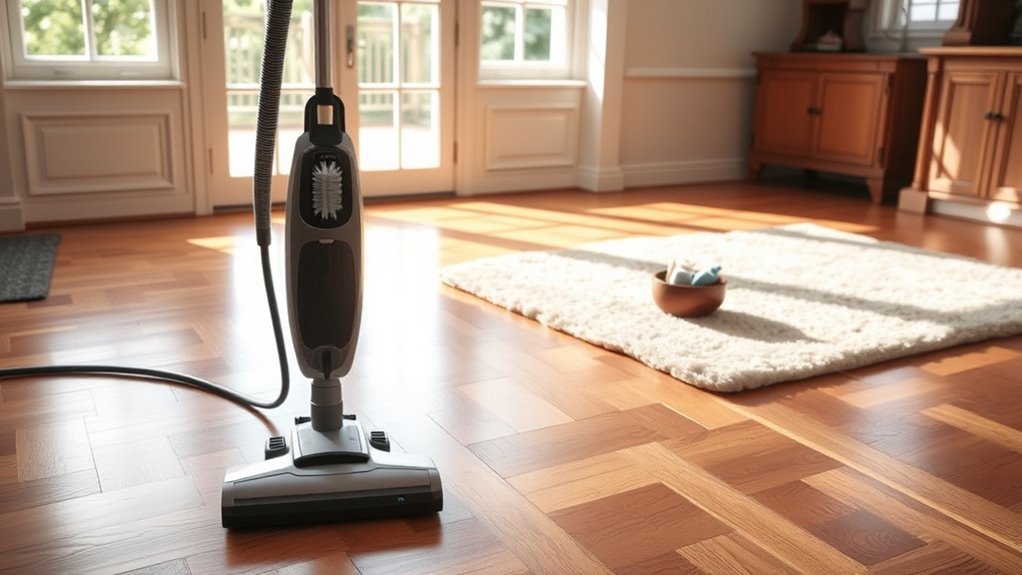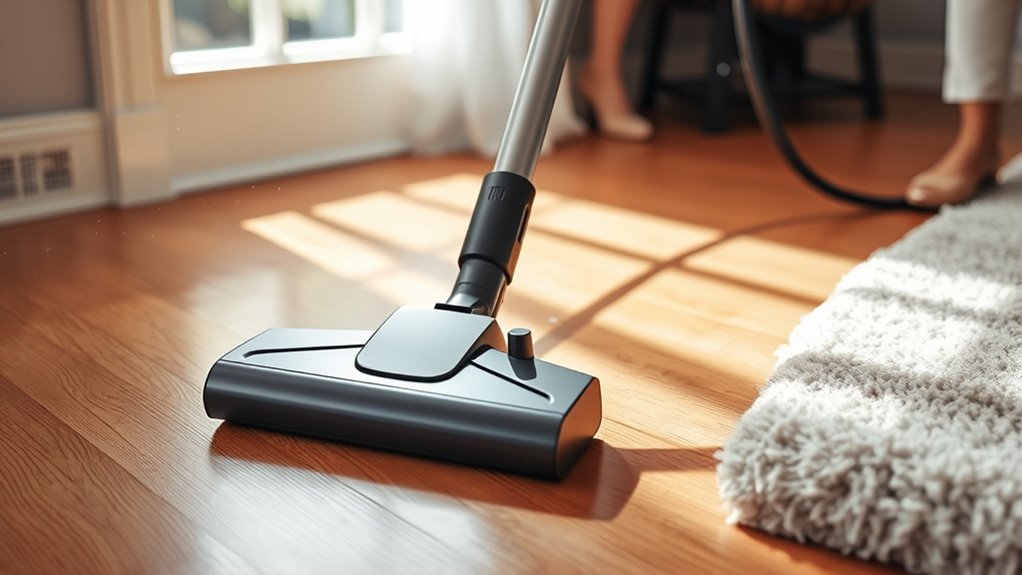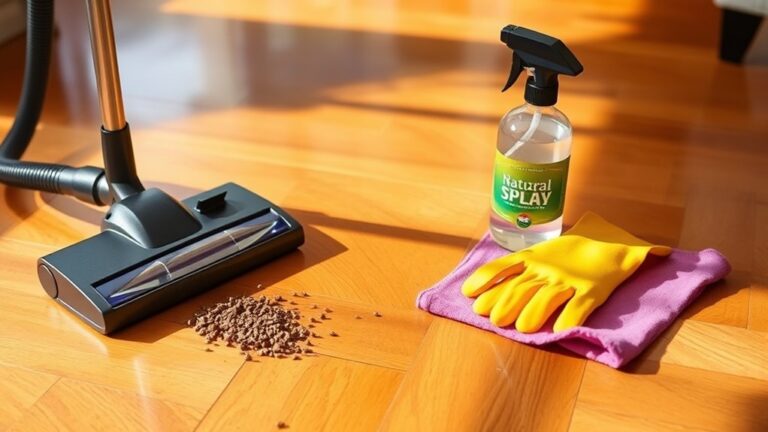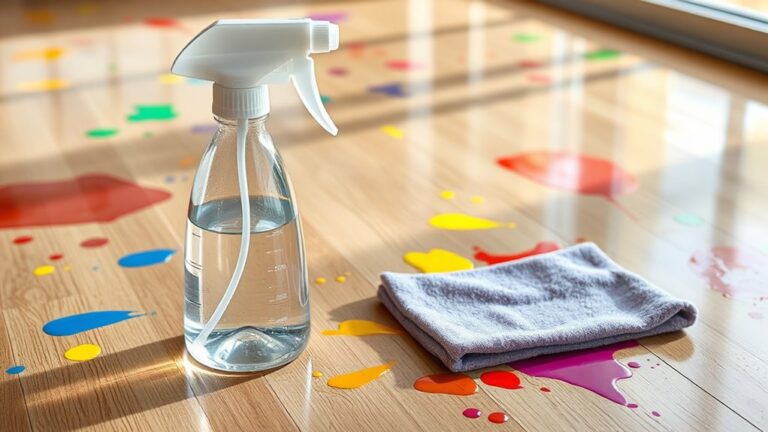You can safely vacuum wood floors by using a vacuum designed for hardwood, preferably with soft wheels and a brush roll that can be turned off to avoid scratches. Always remove small debris and furniture, and avoid beater bars or stiff bristles. Use soft brush attachments, keep your vacuum clean, and vacuum regularly to prevent dirt buildup. These simple precautions protect your floor’s finish while keeping it clean and beautiful—explore more tips to guarantee the best care for your wood floors.
Understanding the Risks of Vacuuming Wood Floors

Although vacuuming is an effective way to clean your wood floors, it can also cause damage if you’re not careful. Using improper vacuuming techniques, such as dragging a vacuum with rough wheels or using a beater bar, can scratch or dent the wood surface. You’ll want to avoid floor damage by understanding how your vacuum interacts with the sol. For instance, vacuum heads with stiff bristles or metal parts can leave marks. To protect your floors, always use attachments designed for hardwood and guarantee the vacuum is free of debris that might scratch. By mastering careful vacuuming techniques, you can enjoy a clean floor without compromising its finish, giving you the freedom to maintain your space safely and effectively.
Choosing the Right Vacuum Cleaner for Hardwood
What kind of vacuum cleaner should you choose to protect your hardwood floors effectively? Opt for models designed with gentle cleaning in mind. Cordless vacuums offer freedom of movement and typically come with adjustable suction settings, making them ideal for hardwood surfaces. Their lightweight design helps prevent scratches and dents. Robot vacuums provide hands-free convenience, especially if they feature soft brushes and sensors to avoid collisions. When selecting, verify the vacuum has a brush roll that can be turned off or a brush specifically made for hard floors to avoid damage. Avoid vacuums with stiff bristles or beater bars, as these can harm your wood finish. Choosing the right vacuum means balancing efficiency and floor safety, allowing you to maintain spotless wood floors without restrictions.
Preparing Your Wood Floors Before Vacuuming

Before you start vacuuming, you’ll want to prepare your wood floors properly to prevent any damage and guarantee effective cleaning. Begin by removing small objects and furniture that could obstruct your path or scratch the surface. Use appropriate cleaning supplies to wipe away any sticky spots or spills, as vacuuming over them can spread residue or damage the vacuum. Check your vacuum for proper floor protection features, such as soft wheels or a brush roll that can be turned off. If needed, place protective pads under furniture legs to avoid scratches when moving pieces. Taking these simple steps assures your wood floors remain safe and clean, letting you enjoy the freedom of a spotless home without risking costly damage.
Using Vacuum Attachments Safely
When you’re ready to vacuum your wood floors, using the right attachments can make a big difference in protecting the surface while effectively removing dust and debris. Opt for vacuum attachment types designed specifically for hardwood, such as soft-bristle brush heads or felt strips, which prevent scratches. Avoid using beater bars or stiff bristles that can damage the finish. Regular attachment maintenance is crucial—clean brushes and check for worn parts before each use to guarantee they don’t trap grit that could scratch floors. Removing tangled hair and debris keeps attachments working smoothly and protects your wood. With proper selection and care of vacuum attachments, you maintain your floors’ pristine condition while enjoying the freedom of easy, effective cleaning.
Techniques for Vacuuming Without Scratching

To avoid scratching your wood floors, always use soft bristle attachments designed for delicate surfaces. Make sure your vacuum’s height is set properly to prevent the brush or wheels from scraping the floor. These simple adjustments help protect your floors while keeping them clean.
Choose Soft Bristle Attachments
Selecting the right vacuum attachments is essential for protecting your wood floors from scratches. Soft bristle attachments offer significant benefits by gently loosening dirt without abrasive contact. Unlike hard plastic or metal tools, these bristles reduce friction, helping you maintain your floor’s finish while effectively cleaning. When choosing attachment types, look for those specifically designed for hardwood surfaces, often labeled as soft or gentle. These usually include brush rolls with natural or synthetic bristles that won’t damage your wood. Using the correct soft bristle attachment allows you the freedom to clean efficiently without worry. This practical choice balances thoroughness and care, ensuring your floors stay pristine and scratch-free for years to come. Always prioritize soft bristle benefits to keep your wood floors looking their best.
Maintain Vacuum Height Properly
Although it might seem minor, maintaining the correct vacuum height is essential for protecting your wood floors from scratches. Different floor types require specific vacuum height settings to prevent the vacuum’s brush or wheels from digging into the wood surface. Start by identifying your floor type—whether it’s hardwood, engineered wood, or laminate—and adjust the vacuum height accordingly. Most vacuums have adjustable settings; set it high enough to avoid contact but low enough to guarantee effective debris pickup. Avoid forcing the vacuum if it feels too low, as this increases friction and potential damage. Regularly check your vacuum’s height settings, especially if you switch between carpet and wood floors. Proper vacuum height lets you clean freely without compromising the beauty of your wood floors.
Frequency of Vacuuming Hardwood Floors
You should vacuum your hardwood floors at least once a week to keep dirt and debris from causing scratches. Factors like pets, foot traffic, and seasonal changes may require more frequent cleaning. Pay attention to visible dust or grit—that’s a clear sign it’s time to vacuum again.
Ideal Vacuuming Schedule
How often should you vacuum your hardwood floors to keep them in top condition? The ideal vacuuming frequency is generally once or twice a week, ensuring dust and debris don’t accumulate and cause scratches. However, you can adjust this routine based on your lifestyle and environment. Seasonal vacuuming adjustments are key—during fall and winter, when more dirt and grit enter from outside, increasing sessions to three times a week can protect your floors better. In contrast, spring and summer might allow for less frequent cleaning. Sticking to a consistent, adaptable schedule helps maintain your wood floors’ finish and longevity, giving you the freedom to enjoy a clean home without overdoing it or risking damage.
Factors Affecting Frequency
Adjusting your vacuuming schedule depends on several factors that influence how quickly dirt and debris accumulate on your wood floors. Environmental factors, such as nearby construction, pollen seasons, or pets, can increase the amount of dust and allergens settling on your floors. Additionally, the level of foot traffic in your home plays a significant role. High-traffic areas, like entryways and hallways, often collect dirt faster, requiring more frequent vacuuming. Conversely, rooms with less movement may need less frequent attention. Your lifestyle also matters; if you often entertain guests or have children, you’ll likely vacuum more often. By considering these factors, you can tailor your vacuuming routine to keep your wood floors clean without overdoing it, giving you the freedom to maintain your space efficiently and comfortably.
Signs to Vacuum More
When should you vacuum your hardwood floors more often? Pay close attention to signs of increased dirt accumulation, like visible dust, pet hair, or gritty particles underfoot. If you notice frequent foot traffic, especially from kids or pets, your vacuuming frequency should increase to prevent scratches and maintain your floor’s finish. Seasonal changes can also bring in more debris, so adjust accordingly. If your floors start to look dull or feel sticky, it’s a clear signal to vacuum more frequently. Regularly monitoring these signs helps you protect your investment without overdoing it. By responding to dirt accumulation promptly, you’ll keep your wood floors clean and extend their life, giving you the freedom to enjoy a beautiful, well-maintained home.
Alternatives to Vacuuming for Wood Floor Care
Although vacuuming is effective, there are times when you might prefer other methods to care for your wood floors. Mopping alternatives, like using a damp microfiber cloth, can gently lift dirt without risking scratches or moisture damage. Microfiber cloths are ideal because they trap dust and debris efficiently, allowing you to clean hard-to-reach corners easily. You can also opt for a dry dust mop, which collects particles without any liquid, preserving your floor’s finish. These alternatives give you flexible options to maintain your floors between vacuuming sessions, especially in delicate areas or when quick touch-ups are needed. Choosing the right method depends on your floor’s condition and your schedule, letting you keep your wood floors clean while protecting their natural beauty.
Maintaining Your Vacuum to Protect Wood Floors
Since your vacuum plays a key role in keeping wood floors clean, maintaining it properly is crucial to avoid damage. Regular vacuum maintenance guarantees your machine works efficiently without scratching or dulling the wood surface. Pay close attention to the brush roll and wheels, as worn parts can cause harm. Also, replace the vacuum’s filter regularly to maintain strong suction and trap dust effectively.
To protect your wood floors, focus on these key vacuum maintenance tasks:
- Remove debris from the brush roll and check for wear.
- Inspect wheels for damage or dirt buildup.
- Perform timely filter replacement to preserve suction power.
- Use attachments designed for delicate surfaces to minimize scratches.




